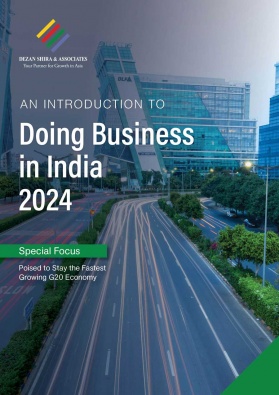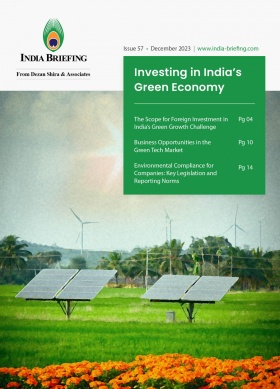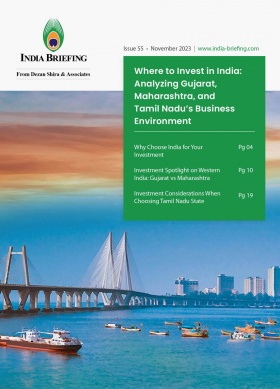Increasing Private Sector Participation Vital for India’s Infrastructure Sector
Infrastructure growth and modernization remain cornerstone objectives for the government of India, with various programs aimed at enhancing connectivity, logistics capacity, and other key areas. Despite consistently allocating a significant portion of capital expenditure to infrastructure projects, private sector investment participation has lagged.
India aims to become the world’s third-largest economy, reaching a GDP of US$5 trillion in the next three years and US$7 trillion by 2030, supported by ongoing reforms. India’s finance minister Nirmala Sitharaman has increased the infrastructure outlay for FY 2024-25 to INR 11.11 billion (US$13.4 million), recognizing the sector’s crucial role in achieving this goal.
In recent years, various initiatives like the National Infrastructure Pipeline and the National Monetization Pipeline (NMP) has driven increased investments, with reforms attracting private investors. Growing government support, particularly for highway projects, aims to enhance economic activities through improved connectivity.
Despite limited foreign investments in infrastructure, India’s robust development makes it an attractive global industrial base, fostering international partnerships, and resulting in positive spillover effects for the economy.
India’s economic ambitions: Banking on infrastructure development
As India seeks to achieve US$-5-trillion-economy status and establish itself as a leading global economy, it must fulfill its developmental promises. With plans to invest INR 143 trillion (US$1.72 trillion) in infrastructure between 2024 and 2030, the sector is expected to become the main driver of the nation’s economic growth.
In January 2024, it was reported that the National Statistical Office’s (NSO) forecast of 7.3 percent growth for the Indian economy in 2023-2024 surpassed the Reserve Bank of India’s (RBI) forecast of 7 percent, reflecting an anticipated investment-driven rebound in the nation. The majority of analysts predict that during the current fiscal year, India’s gross domestic product (GDP) will increase by 6.5 percent to 6.7 percent. The GDP increased by 7.2 percent in FY23.
Meanwhile, former RBI Governor and economist Raghuram Rajan highlights three factors that contribute to India’s resilience amidst the challenges faced by other economies in the post-pandemic period. The economist believes that, contrary to expectations, the industrial world is not experiencing a significant slowdown. Another reason Rajan cites is that Chinese demand for commodities remains subdued, thereby keeping commodity prices, particularly energy prices, at low levels. The situation proves to be beneficial for India, as it stands as a net importer of energy. Rajan also credits the significant infrastructure investments made by the government during the initial two quarters of this fiscal year (FY24) as playing a crucial role. These factors collectively contribute to India’s positive trajectory.
PM Gati Shakti Master Plan
In the 2024 interim budget, the finance minister announced that three infrastructure projects worth INR 960 million (US$11.56 million) were recommended for approval under the PM Gati Shakti initiative.
The three proposed economic railway corridors include energy, mineral, and cement corridors; port connectivity corridors; and high-traffic-density corridors. The government states that the culmination of these projects will not only enhance logistics efficiencies but also significantly reduce costs associated with transportation. The de-congestion of high-traffic corridors is particularly noteworthy, as it promises to improve the operations of passenger trains, ensure enhanced safety measures, and facilitate higher travel speeds.
The PM Gati Shakti Master Plan was first announced on the occasion of India’s 75th Independence Day – August 15, 2021, when India’s Prime Minister Narendra Modi introduced the Gati Shakti Yojana (scheme) with an initial investment layout of INR 1 billion (US$12.05 million). Hailed as a flagship scheme by the central government, PM Gati Shakti is expected to offer a pivotal step towards bolstering India’s infrastructure. The overarching goal of these initiatives is to fortify multi-modal connectivity nationwide, marking the beginning of an era characterized by heightened logistics efficiency and cost-effectiveness.
Initial blueprint of PM Gati Shakti
PM Gati Shakti aims to integrate infrastructure schemes at the ministerial level and state government level, such as like Bharatmala, Sagarmala, inland waterways, dry/land ports, UDAN, etc. Economic zones like textile clusters, pharmaceutical clusters, defense corridors, electronic parks, industrial corridors, fishing clusters, and agri-zones will all be covered under the scheme to improve project execution and enable Indian businesses to become more competitive. The scheme aims to leverage technology extensively, including spatial planning tools with ISRO (Indian Space Research Organisation).
PM Gati Shakti’s approach is driven by seven engines: railways, roads, ports, waterways, airports, mass transport, and logistics infrastructure. Expected to drive India’s economic growth, these seven sectors will work in sync with the central government, state governments, and the private sector. The focus areas include energy transmission, IT communication, bulk water and sewerage, and social infrastructure, creating substantial job and entrepreneurial opportunities, particularly for the youth.
India’s capex spending in the infrastructure sector
At the India Infrastructure Conclave 2023, held in October 2023, global analytics firm CRISIL forecasted that India would allocate about INR 143 trillion (US$1.721 trillion) for infrastructure development in the next seven fiscal years until 2030. This represented a substantial increase compared to the preceding seven fiscal years—in 2017, the allocation was approximately INR 6.7 billion (US$80.80 million).
CRISIL’s InfraInvex report identified specific areas within each sector that need attention and proposed solutions, emphasizing the importance of increased activity in the bond market, attracting more foreign investment, and maintaining robust equity markets to meet the significant funding requirements. The report also acknowledged the numerous infrastructure project announcements made since 2019, aiming for robust economic growth, and highlighted the government’s estimation of substantial investment needed to support both growth and legally compliant infrastructure. Additionally, the report advocated using modern technology to accelerate infrastructure development and enhance its effectiveness.
India Infrastructure Report 2023: Key Takeaways
The India Infrastructure Report, released in December 2023, delves into key aspects influencing the transformation of urban India, underscoring the pivotal role of digital technology, the significance of public-private partnerships (PPPs), the utilization of municipal bonds for financing urban projects, and the importance of effective urban transportation planning. This comprehensive report, jointly prepared by the IDFC Foundation, Infrastructure Development Corporation (Karnataka) Ltd. (iDeCK), and the National Institute of Urban Affairs (NIUA), also addresses critical aspects of floor space and land price regulation, essential components for fostering efficient urban governance.
Within the realm of digital technology’s transformative potential in shaping urban landscapes, the report specifically examines the concept of ‘smart cities’ and underscores the importance of performance ranking criteria. Additionally, the financial dimensions of urban development are scrutinized, focusing on PPPs, the financial sustainability of urban local bodies, and the effectiveness of municipal bonds.
The report, released by former Vice President of India Venkaiah Naidu, highlights that while India has been at the forefront of PPPs, particularly in sectors like roads, ports, airports, and energy, there has been limited implementation of PPPs in the urban sector.
State-wise PM Gati Shakti infrastructure projects
101 number of projects in respect of ports and shipping have so far been identified under the PM Gati Shakti initiative worth INR. 60,872 crores [US$7.33 billion] for implementation. Out of these, 13 projects worth INR. 4,423 crores [US$533.35 million] have been completed.” – India’s Minister for Ports, Shipping and Waterways, Sarbananda Sonowal, Parliament Q&A, 2023
|
Indian state |
Total no. of projects |
Estimated project cost (INR in million) |
|
Andhra Pradesh |
13 |
5871.05 |
|
Goa |
12 |
929.96 |
|
Gujarat |
19 |
20399.15 |
|
Jharkhand |
2 |
345.9 |
|
Karnataka |
10 |
3658.13 |
|
Kerala |
3 |
109.76 |
|
Maharashtra |
13 |
9955.85 |
|
Odisha |
7 |
5528.12 |
|
Pudducherry |
2 |
309.00 |
|
Tamil Nadu |
12 |
12178.8 |
|
Uttar Pradesh |
2 |
355.96 |
|
West Bengal |
6 |
1230.33 |
Source: PIB
The construction and infrastructure industries in India have progressed beyond their initial developmental phases. In recent decades, it has been noted that both public and private entities have prioritized initiatives that promise significant financial returns and are easy to implement.
Consequently, this suggests a tendency for private investors to consider mid or high-risk infrastructure projects. As of 2024, it is still evident that only a limited number of individual investors show interest in engaging with the sector.
A roadblock in urban development: Lack of private investments
In 2024, amidst international interest in investing in India’s infrastructure sector, Japan has expressed its intention to improve India’s border road networks and participate in a transnational power transmission project involving Bhutan, Nepal, and Bangladesh. Recently, Saito Mitsunori, Chief Representative of the Japan International Cooperation Agency (JICA) India, discussed the progress of the Mumbai-Ahmedabad High-Speed Corridor project, expressing satisfaction with its advancements. JICA has served as a crucial and long-time funding partner for various major infrastructure projects in India, including metro projects and rural development initiatives.
Undeniably, a shift from relying solely on public capital expenditure to integrating private investment in infrastructure development has begun, and it has become imperative that the central government promote measures and strategies to mitigate investment risks for foreign players.
FDI rules have been significantly liberalized in India and can provide foreign investors with options aligned with their business goals.
Based on levels of regulatory screening, there are two routes of foreign investment:
- Automatic route: The automatic route permits foreign investors to engage in Indian sectors without needing prior approval, requiring only notification to the Reserve Bank of India (RBI) within a specified timeframe. This approach enhances ease of doing business, attracts foreign capital, and is particularly favorable for sectors with higher FDI limits or without specific security concerns.
- Government approval route: The government approval route mandates prior approval from the Indian government or relevant ministries for foreign investors, typically reserved for sectors involving national security, strategic interests, or specific regulatory concerns. This ensures government control over sensitive economic areas while allowing foreign investments on a case-by-case basis.
|
Sector |
FDI limit |
Entry route |
|
Banking – public |
20% |
Government approval |
|
Banking – private |
74% |
|
|
Insurance |
74% |
Automatic |
|
Asset Reconstruction Companies |
100% |
Automatic |
|
Mining |
100% |
Automatic |
|
Petroleum & natural gas refining |
100% |
Automatic |
|
Defense manufacturing |
100% |
|
|
Telecom |
100% |
|
|
Railways |
100% |
Automatic |
|
Power exchanges |
49% |
Automatic |
|
Construction development |
100% |
Automatic |
|
Industrial parks |
100% |
Automatic |
|
Satellites |
100% |
Government approval required |
|
Electricals machinery and system |
100% |
Automatic |
|
Ports and shipping |
100% |
Automatic |
The Indian government is attempting to promote private and foreign investment through initiatives like a liberal FDI policy, Ease of Doing Business measures such as the National Single Window System (NSWS), and fiscal incentives. The synergy of PM Gati Shakti, the Project Monitoring Group (PMG), and public-private partnerships (PPP) constitutes the foundation of these de-risking initiatives. The PMG is an institutional mechanism for expedited resolution of issues and regulatory bottlenecks in projects with an investment of INR 5 billion (US$60.25 million) and above in India. The NSWS is an online platform that allows entities to secure government approvals without having to physically approach 31 central government departments and 22 state governments. The portal offers tracking of application status and speedy response to queries.
The government hopes that by introducing measures to de-risk investments by incorporating technology, employing an integrated planning approach, and implementing rationalized risk-sharing mechanisms, the infrastructure sector will become more attractive to foreign players. As of now, substantial foreign investment is yet to be seen in this space, which may also be a reflection of tightened FDI scrutiny of Chinese investment proposals as well as prioritizing legal safeguards. Further, infrastructure disputes take much longer to reach resolution in India as compared to other markets.
FDI equity inflows in India for financial year 2023
|
Sectors |
FDI amount (in US$ million) |
|
Computer hardware and software |
9,394.00 |
|
Service Sectors |
8,707.00 |
|
Trading |
4,792.00 |
|
Drugs and Pharmaceuticals |
2,058.00 |
|
Automobile |
1,902.00 |
|
Chemicals (other than fertilizers) |
1,850.00 |
|
Construction (infrastructure) activities |
1,703.00 |
|
Telecommunication |
713.00 |
|
Metallurgical industries |
219.00 |
|
Construction development |
146.00 |
Source: Statista
To instill confidence among international investors, the PPP model can serve as a mechanism for fair and balanced risk-reward distribution between public authorities and private partners. Over the past 30 years, PPP in India has transformed from merely an additional budgetary resource for project financing to a robust tool. It has attracted private capital, incorporating advanced technologies and best practices in infrastructure development. Since 1991, this approach has attracted private capital totaling around INR 68 trillion (US$819.83 billion) for over 9,200 infrastructure projects.
Election gambit: Infrastructure’s political power play
With the 17th general elections scheduled to take place in the coming months, the BJP-led central government is betting on the popularity of infrastructure as a fiscal stimulus. Infrastructure transformation has the ability to yield tangible and visible outcomes that may appeal to voters. The sector can generate substantial economic stimulus, including employment, surpassing the impact of various other forms of spending.
Need for greater private sector involvement
According to the World Bank’s Private Partnership in Infrastructure (PPI) report for 2022, among the 263 globally recorded projects, 44 percent had a majority of stakes sponsored by foreign entities, consistent with 2021 and 2020 figures. The energy sector was a primary focus for foreign sponsors, accounting for 63 percent of projects. In terms of investment volume, foreign entities sponsored 34 percent of projects, totaling US$30 billion.
The report stated that the region with the highest number of internationally sponsored projects was Latin America and the Caribbean (LAC), where the United Kingdom was the main country of origin. This was followed by Sub-Saharan Africa (SSA) with 81 percent of projects sponsored by foreign entities, mainly from France. According to the PPI report, France led in sponsoring the most international projects (20), followed by the United Kingdom (12), the United Arab Emirates, and Spain (both with nine). In terms of investment volume, Spain and France were the top countries of origin, sponsoring projects worth US$5.2 billion and US$3.4 billion, respectively.
Domestically sponsored projects accounted for 55 percent of the total (144 projects), with significant contributions noted in China, India, and Brazil. In China, 47 projects were predominantly domestically sponsored; in India, 22 out of 30 projects; and in Brazil, a near split with 28 domestically sponsored projects out of a total of 55.
With the ambition of becoming a developed country by 2047 and achieving a GDP of US$7 trillion, India will need a proportionate increase in private investment in its infrastructure sector.
Conclusion
In 2023, significant business events unfolded, such as Walt Disney exploring strategies for growth and cost reduction in its Star India business, Havas’s Indian arm acquiring PivotRoots, and private equity investors competing for the acquisition of Mumbai-based Indira IVF Hospital Pvt. Ltd. Singapore Airlines secured a 25.1 percent stake in the Air India group for US$267 million.
Notably, these developments did not involve foreign investments in India’s infrastructure sector.
At the same time, there has been a deliberate surge in state-sponsored infrastructure investment as part of a long-term strategy to stimulate India’s economic growth.
While the focus on infrastructure is pivotal for enhancing India’s global standing and boosting its manufacturing sector capacity, the country needs more global partners and private capital to ensure projects are aligned with international best practices and technologically advanced. There is scope via the PPP model and using private vendors and high-tech startups at critical planning and construction stages. However, reforms will be needed to make this a viable proposition, from transparency on project bids, implementation timelines, incentive payouts, and dispute resolution.
US$1=INR 82.99
About Us
India Briefing is produced by Dezan Shira & Associates. The firm assists foreign investors throughout Asia from offices across the world, including in Delhi and Mumbai. Readers may write to india@dezshira.com for more support on doing business in India.
We also maintain offices or have alliance partners assisting foreign investors in Indonesia, Singapore, Vietnam, Philippines, Malaysia, Thailand, Bangladesh, Italy, Germany, and the United States.
- Previous Article Ongoing Red Sea Crisis Compels Global Shipping to Find New Routes
- Next Article Emerging Technologies Supporting Your India Retail Strategy: Location Analytics









